In 1915, the French Darne company – best known for sporting shotguns – entered the military market with a contract to manufacture Lewis guns for the French Army. Apparently some of the folks at Darne thought they could do better than the Lewis, and the company developed its own machine gun design during the war.
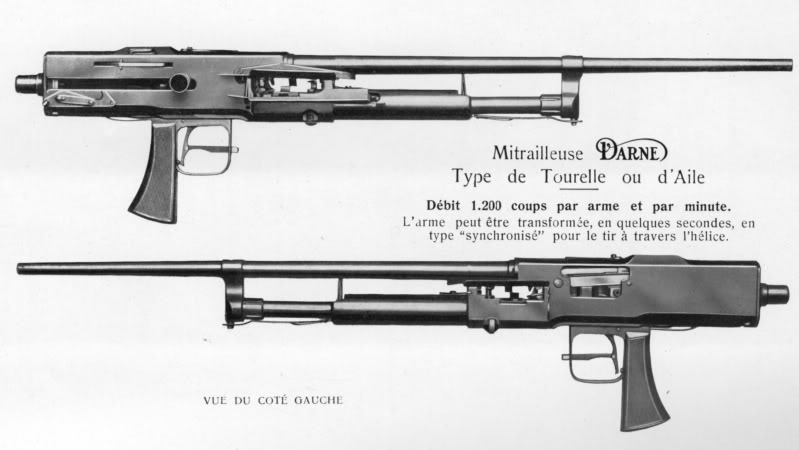
The Darne M1918 was tested by the French military, but was not put into production before the end of the Great War. However, it was purchased after the war, primarily as an aircraft gun. Several variants were made, including infantry guns, fixed-mount aerial guns, synchronized aerial guns, and flexible-mount aerial guns. It was eventually replaced by the MAC 1934 for Air Force use, although the French Navy continued to use them into WWII. Small numbers were also exported to Brazil, Spain, Serbia, Italy and Lithuania, and captured French Darnes were used by German occupation forces for coastal defense.
Mechanically, the Darne is a gas-operated, belt-fed, tilting bolt design. It is rather unusual in that the belt feed is located below the barrel but above the gas piston, although this configuration doesn’t appear to offer any particular advantage or disadvantage. Both cloth and disintegrating metal belts were used, with cartridges pulled rearward out of the belt pockets and then lifted up to bore level. The bolt tilts upwards to lock into a recess in the top of the receiver, much like a BAR.
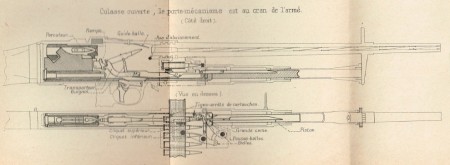
Early versions of the Darne were chambered for the 8mm Lebel cartridge, but the gun was quickly updated to the new 7.5mm French military cartridge. Some export guns were also made in 8mm Mauser, and possibly other cartridges. The initial guns were made by Darne in France, but it appears that later production was outsourced to Spain, where it could be done cheaper.
Cowan’s Auctions is has three Darne guns in their upcoming auction of the Richard Wray collection – one flexible-mount AN40 version, and a matching pair of left- and right-hand feed guns set up on an antiaircraft mount. You can see some of their excellent photos of these guns here:
[nggallery id=188]
[nggallery id=189]
We also have a copy of a 1923 French manual for the Darne, which can be downloaded as a PDF:
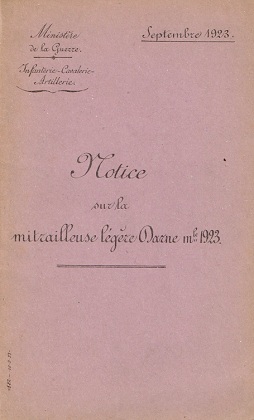

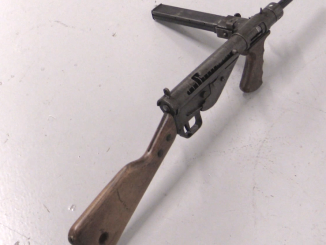
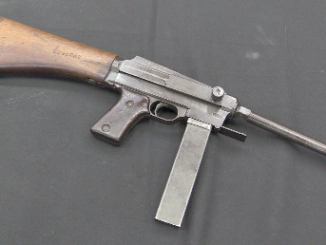
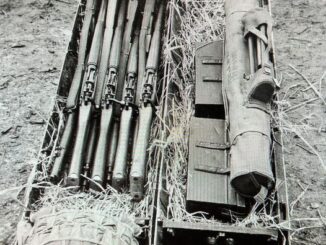
That dual rig is simply lovely.
I gather that after WWi the French government introduced a punitive tax on any company producing war materials.
I’m guessing it was in part a populist measure,
as rushing into a war (in favour of Serbia and Russia) and ending up fighting it on your own soil for 4 and a bit years is hardly going to go down well with the plebs.
and partly due to the bankrupt state of the French government (which also explains the punitive reparations Germany got saddled with, in the Versailles treaty)…
Can’t have bureaucrats forced to cut back on their little luxuries – regardless of what the long term and more widespread repercussions may be.
I gather the tax removed the French lead in aero-engine technology and put the French aero engine manufacturers out of business, leaving the world market free for the likes of Rolls Royce, Bristol and Pratt & Whitney.
Darne’s outsourcing (I’m guessing to the Basques) may have been as much to avoid that tax, as it was to find a lower cost producer so that the machinegun wasn’t competing for floor space, man power and machine time, with their high value shotgun line, in their little St Etienne works.
Keith, I must disagree reg. the following statement: “I gather the tax removed the French lead in aero-engine technology and put the French aero engine manufacturers out of business, leaving the world market free for the likes of Rolls Royce, Bristol and Pratt & Whitney”.
French aero engine manufacturers like Hispano-Suiza and especially Gnome-Rhône (mostly with radial engines) did brisk business in the inter-war era, mostly after WWI surplus got exhausted. Both firms did well even during and after the Big Depression, with good sales both at home and abroad. Another important French aero engine manufacturer was Lorraine-Dietrich, which produced a successful series of in-line W engines (Lorraine 12 Eb, 12 Edr, etc) for most of the 1930s.
Here’s an interesting PDF article on the history of Hispano-Suiza aero engines:
http://www.hydroretro.net/etudegh/hispanosuiza.pdf
French aircraft manufacturers also did pretty well during the same period, exporting literally hundreds of (mostly) military aircraft to European and Latin American clients from roughly the mid-1920s to the late 1930s.
As for the Darne machine guns, they were also exported in sizeable numbers to Romania, a major client of the French war industry up to the early 1930s. They were used in fixed, synchronised mounts and in single and double rigs manned by the observer in many aircraft in the inventory of the Aeronautica Regală Româna.
Thanks
I’ll go back and check where I got that from, not sure whether it was Gunston’s biography of Fedden (Bristol engines) or Nahum’s book on rotary radial engines.
(my books are a mess with pencilled scribblings in the margins – looks like an excuse for another scribbling)
Excellent post!
The Darne Mle 1923 machine gun was designed and manufactured with pure operational utility in mind. It was roughly finished where finish was only regarded as a cosmetic issue and looked flimsy at first glance, but was actually well-made and precisely toleranced where it mattered from a mechanical and functional standpoint. The end result was a gun that was less expensive to make but which was accurate, reliable and versatile in its intended roles. Definitely an under-rated weapon that has been largely ( but not entirely ) forgotten with time.
Exactly Earl. The Spanish Arma de Aviación used the Darne in their air policing operations in the Rif to good effect and both ground crews and pilots praised it as a very reliable gun. Not a fancy one, just as a good tool that delivered exactly what was expected of it. Apparently, it was as well liked as the much more expensive Lewis machine guns also employed as obeserver guns by the Spanish air arm.
So here is the reply; I should have read it beforehand. The design is definitely on ‘subtle’ side.
http://www.cowanauctions.com/auctions/item.aspx?ItemId=120269
i did not know there were 12 ga Mausers
If you showed me the layout from manual before buiding the gun, I’d say this is not gonna last hundred rounds (I am refering to cartridge lifter). But it apparently did work. Were these guns favored/ liked by their userd?
Ian, I just wanted to say how grateful I am for your posting of this article. I had brought up the Darne machine gun in a side topic in another article on FW some months ago and you had said at the time that there was possibly something pending on it. I guess this is it! Once again, many, many thanks for remembering.
Gentlemen,
if you will browse through the manual up to the end, you will see some interesting illustrations of the ground version of the Darne LMG
Belt-fed gun, which can be used either from bipod or from tripod…
and more than 10 years ahead of the universally acclaimed “first ever GPMG” MG.34…
That was my first thought when I looked at it. Its furniture looks more ‘consolidated’ than that in pictures and indeed quite modern. The French have had the ability to produce many industrial leading designs.
Yes Max, I too noticed those line drawings at the end of manual. Régis Darne and his son surely knew how to think out of the box, especially if one takes into account the fact that they started in work on their machine gun in 1916… The only feature that seems to be absent from that pioneering ‘GPMG’ is a quick change barrel, possibly because the pattern was set by the aviation gun. It was simply called ‘mitrailleuse portative’ and had a fire rate of up to 1000 rpm, being fed by 150 or 200 rounds cloth belts.
The Darnes also designed a magazine-fed ‘Fusil Mitrailleur’ that could use 20, 25 and 30 round magazines.
Still, and despite its promise, the ground ‘portative’ Darne didn’t sell very well, perhaps because prospective buyers failed to fully understand its tactical potential…
Does anyone know the purpose of the weirdly shaped pistol grip? I’ve been puzzled by that since I first read Smallarms of the World in the summer between 7th and 8th grades in the late ’60s.
It seems common to all of the versions of the gun I’ve seen, but has no benefit I can imagine. It gives the gun it’s characteristic “John Carter of Mars” look also shared by a number of Japanese firearms.
My guess is that since the Darne was originally designed as a hand-held aircraft observer’s gun, the pistol grip was shaped to suit the accepted gun handling and firing techniques of the time associated with that use. It may have been subsequently found that the same pistol grip configuration was still acceptable, if not ideal, for the gun’s expanded roles in other applications, so Darne chose to keep it in the interests of holding down costs and simplifying manufacturing.
Possibly it was designed with the gloved hands of the observer in mind. Accordingly, the pistol grip of the ground versions had a different shape.
I thought the ground guns had the same shaped pistol grip.
The ground guns had a more conventionally shaped pistol grip; this is evident in the drawings in the last pages of the manual and also in the relevant page at Max’s website: http://world.guns.ru/machine/fr/machine-gun-darne-e.html
The French came up with great firearms but they tend to be underestimated. It even came with a foregrip: http://img855.imageshack.us/img855/6120/22193047q37q0lsp.png
Interesting — I wonder if the addition of the foregrip was a concession to a remaining hold-over of the World War One tactical concept of “walking fire”, or could it simply be Darne’s attempt to provide better firing control when used in the dismounted mode, a sort of precursor to the more modern LMG developments of today?